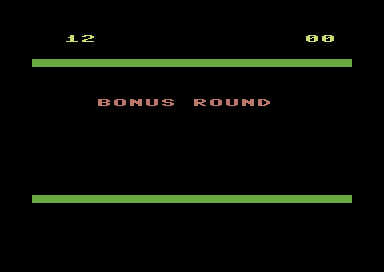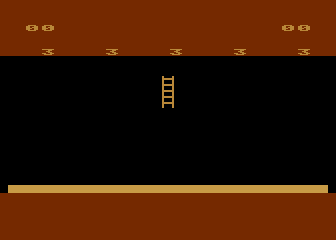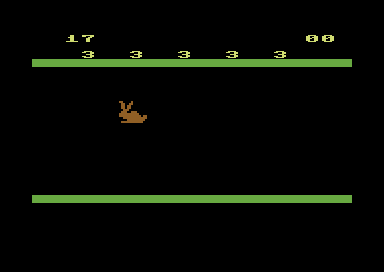Retro Replay Review
Gameplay
Kids on Keys delivers a trio of bite-sized typing challenges that gradually ramp up in complexity, ensuring that young learners remain both engaged and appropriately tested. The first mini-game starts simply, with single letters drifting down the screen. As players progress through four skill levels, these letters begin to fall faster, encouraging quicker reflexes and reinforcing key-to-letter associations. The climactic twist—typing out an entire word as the cheerful mascot floats downward—serves as a satisfying culmination of what began as individual keystrokes.
(HEY YOU!! We hope you enjoy! We try not to run ads. So basically, this is a very expensive hobby running this site. Please consider joining us for updates, forums, and more. Network w/ us to make some cash or friends while retro gaming, and you can win some free retro games for posting. Okay, carry on 👍)
The second mini-game builds on this foundation by presenting recognizable icons of everyday household objects. Rather than typing single letters, players must now input the full names of these items before they reach the bottom of the screen. This shift not only reinforces spelling patterns but also expands the child’s vocabulary, linking visual memory to language in a fun, interactive way. Each correct entry accelerates the pace, creating a dynamic learning environment that balances achievement with challenge.
The third and final game adds yet another layer of cognitive exercise: memory. An object’s name appears at the bottom of the screen, and the player must punch in the corresponding numerical code tied to the matching icon floating overhead. Periodic bonus rounds heighten the mental workout by partially obscuring these icons, compelling players to draw upon their recall rather than simple recognition. This blend of typing, visual matching, and memory makes Kids on Keys a well-rounded educational tool rather than a one-dimensional drill.
Graphics
Given its early 1980s heritage, Kids on Keys embraces a minimalist visual style that remains charming. On vintage microcomputers, the sprites are limited to a handful of colors and blocky pixels, yet each icon—whether it’s a teapot, a book, or a toothbrush—is instantly identifiable. The simplicity is intentional, stripping away distractions so that the focus stays squarely on learning to type.
The game’s color palette, dominated by bright primaries, helps maintain attention and provides clear contrast against the black background. While today’s players might find the visuals crude, they carry a nostalgic warmth that many educators of the era found appealing. The mascot—often depicted as a friendly cartoon character—adds personality without compromising legibility, making Kids on Keys both functional and inviting.
Animations are sparing but effective: letters and icons descend smoothly, accelerating at each new level to signal increasing difficulty. The feedback for correct key presses—brief beeps and the disappearance of characters—reinforces learning with immediate gratification. Though primitive by modern standards, the graphics serve their educational purpose admirably and still offer a retro charm for curious parents and kids alike.
Story
Unlike adventure titles or narrative-driven games, Kids on Keys doesn’t follow a traditional storyline. Instead, it frames the learning process as a friendly challenge issued by its mascot, transforming mundane drills into a series of mini-quests. This loose narrative structure fosters a sense of progression—each completed level feels like a milestone in the journey toward typing mastery.
The mascot itself, though not heavily characterized, plays a key role in tying the three games together. Its gentle encouragement and occasional playful animations give the title a cohesive feel, as though a wise, whimsical guide is ushering players from basic letter recognition to more sophisticated memory tasks. In this way, the story isn’t about rescuing a kingdom or exploring distant worlds; it’s about the child’s own journey to confidence and competence at the keyboard.
By embedding educational goals within the framework of challenges and rewards, Kids on Keys crafts its own narrative arc. Players aren’t following a plot in the conventional sense, but they do experience a palpable sense of advancement—unlocking faster speeds, higher difficulty tiers, and bonus rounds that test both memory and typing agility. The story here is one of personal improvement, a theme as timeless as any fairy tale.
Overall Experience
Kids on Keys stands out as a thoughtfully designed educational title, ideal for introducing young children to the world of typing. Its escalating difficulty curve keeps beginners engaged while offering enough replay value to challenge more adept typists. The inclusion of memory-based bonus rounds in the latter games adds unexpected depth, ensuring that players develop a range of cognitive skills alongside their typing speed.
While the graphics and sound effects are clearly products of the early microcomputer era, they possess a retro charm that can feel refreshing in today’s hyper-realistic gaming landscape. Modern kids might need some context to appreciate the simplicity, but the core gameplay remains as relevant as ever: practice, reward, and progress. Parents and educators will find the clear feedback loops and adjustable difficulty levels especially valuable for tracking and encouraging improvement.
For buyers seeking a pure educational supplement rather than entertainment-first gaming, Kids on Keys delivers exactly what it promises. It’s not designed to compete with contemporary platformers or narrative adventures, but as a targeted tool to build reading fluency and typing confidence, it excels. Ultimately, this mini-game collection offers a charming, no-frills path to fundamental computer literacy skills—making it a worthy addition to any young learner’s software library.
 Retro Replay Retro Replay gaming reviews, news, emulation, geek stuff and more!
Retro Replay Retro Replay gaming reviews, news, emulation, geek stuff and more!









Reviews
There are no reviews yet.